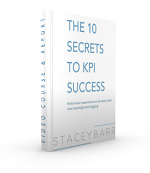5 Dangers of Off-the-Shelf KPIs
by Stacey Barr |Where can I find KPIs for brand management? What are the right KPIs for machine reliability? What are some good governance measures? If you’re shopping for off-the-shelf KPIs, from KPI libraries or KPI lists, there are dangers in this approach that deliberately designed KPIs don’t have.

There are plenty of places to search off-the-shelf KPIs in their thousands:
- kpilibrary.com
- smartkpis.com
- kpimegalibrary.com
The founder of one of these KPI libraries says this:
“Selecting KPIs is like picking flowers from a field. You can’t pick all of them. Instead you have to decide on the right combination and a limited number to make a beautifully balanced bouquet… Using your nose generally helps.”
I disagree entirely. Selecting KPIs needs to be far more deliberate and designed than limiting yourself to the type and number of flowers you pick from a vast field. Following your nose means doing what you’ve always done. Your KPIs suck right now, don’t they? Why else would you be reading this?
Following your nose will only get you where you’ve been before. More bad KPIs.
Don’t get me wrong – I do support this idea of KPI banks because they are a good source of *potential measures*. But they are NOT a process for making the final selection. If you treat them as though they are, heed these warnings:
Danger #1: You will collect more data than you need.
The temptation (much as I face with dark chocolate) of KPI libraries is that you take more than you need. Just in case. You don’t want to miss anything important.
So you end up measuring far more than you need to, and you will bear the cost of all that data collection, collation, analysis and reporting, irrespective of the resulting value.
Danger #2: You will focus on things that aren’t priorities (and not focus on things that are).
With lots of KPIs or measures that relate to your industry or sector or function (as opposed to a few that relate to your goals or priorities), you will be staring at a dashboard or report that is swirling with detail.
Where should your eyes go first? No doubt to the KPIs that show bad results. Bad results must be fixed. But should you fix a bad result that doesn’t matter? Or a mediocre result that matters a lot? How will you tell the difference?
Danger #3: You’ll end up with too many KPIs and be overwhelmed into inaction.
Maybe you’ll have so many KPIs that… Hang on, I keep calling them KPIs. But the ‘K’ stands for ‘key’. What’s ‘key’ about dozens of measures that you will never have the time to manage and improve with excellence?
Your KPI shopping trip will give you too many measures that your brain just won’t be able to digest. If you can’t think clearly, you can’t act decisively. So you procrastinate and do nothing significant to truly elevate performance.
Danger #4: You won’t get people to take ownership of the KPIs.
We all love it, don’t we, when someone tells us “Here are your KPIs. Now start performing.” Hardly. I’ve never met a soul that could truly own a performance measure they didn’t have a hand in choosing.
What’s more, off-the-shelf dashboards and KPI collections always come without any overarching purpose or outcome to be achieved. It’s damn hard to ‘start performing’ when you have no inspiration for why it matters, or it’s clear that it doesn’t matter.
Danger #5: You will reinforce bad KPI habits and a misunderstanding of performance management.
Why do so many people assume that the outcome of performance measurement is a dashboard? Having KPIs or measures is not the holy grail. Achieving your goals sooner and with less effort is the holy grail of performance measurement.
You’ll choose better measures when you can anticipate the return you will get on your investment in measurement: bigger improvements in the outcomes you most want.
What to do instead…
Like I said before, selecting KPIs needs to be far more deliberate and designed than limiting yourself to the type and number of flowers you pick from a vast field. This is why an approach like PuMP is so vital. It gives a more deliberate approach than you would ever expect so you stop wasting time with KPIs that suck.
One of the PuMP techniques, Measure Design, has 5 steps to guide you to choose the absolute fewest KPIs or performance measures that directly evidence the goal or result you want to monitor. Step 3 in this technique is where you can start scanning the KPI libraries for potential measures.
Steps 1 and 2 of the PuMP Measure Design technique make sure you clearly define the evidence the measure should provide to convince everyone the result is happening. And steps 4 and 5 make sure you choose the best of the potential measures.
Don’t follow your nose. Be deliberate.
TAKE ACTION:
Do you use KPI libraries? What do think about them? Let’s chat on the blog.
Connect with Stacey
Haven’t found what you’re looking for? Want more information? Fill out the form below and I’ll get in touch with you as soon as possible.
167 Eagle Street,
Brisbane Qld 4000,
Australia
ACN: 129953635
Director: Stacey Barr




